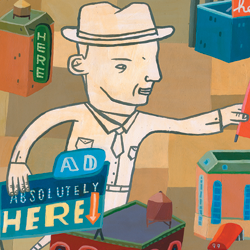 |
 Candy Adams,
Candy Adams,
CTSM, CME,
CEM, CMP, CMM,
"The Booth Mom,"
is an independent exhibit-management
consultant, trainer, speaker, writer, and an Exhibitor conference
faculty member.
CandyAdams
@BoothMom.com |
| |
 ealing with labor unions and their complicated jurisdictions, labor laws, and contracts on the trade show floor can be a confusing - and expensive - ordeal. To complicate matters even more, unions and their contracts vary from state to state and even city to city. While you may be allowed to put up your own pop-up exhibit and plug in product demos at one show, both actions may be verboten at the next. But with a bit of research before each show, you can find out which unions have contracts at the show, what their jurisdictions are, and what you are allowed to do by yourself without getting in trouble. ealing with labor unions and their complicated jurisdictions, labor laws, and contracts on the trade show floor can be a confusing - and expensive - ordeal. To complicate matters even more, unions and their contracts vary from state to state and even city to city. While you may be allowed to put up your own pop-up exhibit and plug in product demos at one show, both actions may be verboten at the next. But with a bit of research before each show, you can find out which unions have contracts at the show, what their jurisdictions are, and what you are allowed to do by yourself without getting in trouble.
To help you, here's a basic rundown of how unions operate, how jurisdictions work, what you can and can't do, and how to avoid a turf war with union stewards.
What is a Union?
Union members pay dues to belong to a union that provides them with representation in contract negotiations on wages, benefits, hours, seniority, and working conditions; sets regulations for mediating disputes; and provides education and benefits (such as insurance, vacation, and pension plans).
Unions also operate a hiring hall, a placement center where a show's general services contractor (GSC) and exhibitor appointed contractors (EACs) that need union labor do a "call" for the number of laborers and the skill level they require. Although some contractors maintain a full-time employment relationship with union members, many laborers float from one installation-and-dismantle provider to another, depending on who has work for them. While working a huge show in Los Angeles a few years ago, I saw one union laborer wear seven different shirts, identified with the GSC and various EACs, over the course of an eight-day setup.
Union laborers generally start their careers in a union-sanctioned apprenticeship program. When they attain a mandated number of hours of education, expertise, and on-the-job experience, they become journeymen. Due to insufficient labor in some areas, unskilled (or casual) laborers, known as readymen, can also be called on to do basic manual labor through a temporary personnel agency.
Laborers are also sometimes referred to by letters. An "A" laborer is a highly skilled laborer, usually a journeyman. A "B" laborer is an apprentice, and a "C" laborer is considered unskilled, temporary, and possibly non-union labor, depending on how shallow that area's labor pool is and the number
of union members available.
If you are hiring a team of union laborers in your exhibit, one person, generally with journeyman status, will be appointed as the lead, and will be paid a small cash incentive over his or her normal hourly rate for serving as the liaison to the exhibitor, making sure the job is performed to your satisfaction, and leading the rest of the crew.
But beware: Just because you are told you will have a journeyman leading your crew doesn't mean he or she is really qualified. At one of the largest trade shows where qualified journeymen are at a premium, I was assigned a journeyman drywall hanger who'd never been on a show floor before. It turned into my job to teach him how to lay the carpet in my exhibit while I paid him at the overtime rate.
Whose Turf is it Anyway?
Some unions are found nationwide. Other unions may be more regional in scope, and you might only deal with them in one city. Each union claims its own specific jurisdiction, i.e. the authority to perform certain duties as stipulated in the union contract.
Unions elect union stewards to ensure that union members - and union members only - perform any work that falls within the jurisdiction of the union contract. If an exhibitor breaches that contract by performing a function that should be done by a union laborer, he or she is required to pay the correct party for the labor anyway. If another laborer performs a function in another union's jurisdiction, the unions settle the dispute between them. In San Francisco, for example, both the International Alliance of Theatrical Stage Employees (IATSE) Local 16 and the Sign Display & Allied Crafts Local Union 510 claim jurisdiction on hanging plasma monitors. To avoid an argument on the show floor, my answer was to hire a laborer who carried cards for both unions.
Because union steward is an elected position, some are overzealous in protecting their turf, picking battles that don't really overstep their jurisdiction or take bread from the mouths of their members. Being highly visible and vocal is a plus in the eyes of their constituency and will help get them re-elected.
For example, at a different show in San Francisco, a union steward informed me that I could not staple small identifying notes on the end of CAT5 cables that needed to be laid under my exhibit's carpet (the notes were to help me identify which cables connected to each piece of equipment after running them under the pad and carpet). I was neither laying the cables nor taping them to the floor (which electricians in San Francisco claim the jurisdiction to perform), and I had placed an advance order for an electrician who had not shown up at the requested time. I told the steward that if he could get me an electrician, I'd let him use my tiny stapler. Within 15 minutes, I had an electrician.
If you're already on the show floor and you run into a jurisdiction issue, start the resolution process with floor managers, the people show management places on the show floor to run interference and keep their exhibitors out of the line of fire. If they can't solve the problem, ask them to radio the show's operations manager. By this time, the union(s) involved will probably have already contacted their on-site union stewards. The good news is that situations rarely escalate to this, but it can happen.
Since there are so many unions and various local contracts, it's really tough to nail down who can do what and where. When in doubt about what unions will be represented on your trade show floor, what their jurisdictions cover, and what functions you, as the exhibitor, can perform, call the operations department of show management. (Note: This department might refer you to the GSC's labor department for answers.)
Show management should be able to provide you with a list specific to your venue, but here's a generalized list of I&D duties and who usually performs them:
 Move freight. This is generally a function of teamsters (union members who deliver large crates/pallets with forklifts), even though in some cities, temporary or casual non-union labor is hired to move cartons on dollies in lieu of teamsters. Move freight. This is generally a function of teamsters (union members who deliver large crates/pallets with forklifts), even though in some cities, temporary or casual non-union labor is hired to move cartons on dollies in lieu of teamsters.
 Build exhibits. The number of unions that have jurisdiction over uncrating, installing, dismantling, and re-crating exhibits varies depending on the city. Build exhibits. The number of unions that have jurisdiction over uncrating, installing, dismantling, and re-crating exhibits varies depending on the city.
 Decorate the hall. Some cities have a separate decorators union dealing with drape and decoration. Decorate the hall. Some cities have a separate decorators union dealing with drape and decoration.
 Rig signs/lighting and un-skid equipment. Riggers hang signs or move large equipment off pallets and position it in your exhibit. Rig signs/lighting and un-skid equipment. Riggers hang signs or move large equipment off pallets and position it in your exhibit.
 Lay carpet. In some cities, carpet, pad, and protective covering can be laid by the carpenters' or decorators' unions, but a separate carpet-layers' union can also be found in more than a few venues. Lay carpet. In some cities, carpet, pad, and protective covering can be laid by the carpenters' or decorators' unions, but a separate carpet-layers' union can also be found in more than a few venues.
 Complete electrical work. Electrical unions have jurisdiction over all power-related functions, whether performing floor work such as running your under-carpet cable, assembling and hooking up lighting fixtures and signs, or managing large power loads (208V). Complete electrical work. Electrical unions have jurisdiction over all power-related functions, whether performing floor work such as running your under-carpet cable, assembling and hooking up lighting fixtures and signs, or managing large power loads (208V).
 Install plumbing. Plumbers work with air, water, waste, gas lines, tanks, heating, cooling (including refrigeration), and ventilation. Install plumbing. Plumbers work with air, water, waste, gas lines, tanks, heating, cooling (including refrigeration), and ventilation.
 Set up audiovisual and staging for theatrical products. Stage and theatrical workers' unions often claim jurisdiction over AV work that includes projecting images on a screen, adjusting lights, raising and lowering scenery, positioning microphones and equipment, creating and editing sound effects, controlling equipment that regulates sound and picture quality, rigging and scenery for theatrical productions, and even some decorating tasks. Set up audiovisual and staging for theatrical products. Stage and theatrical workers' unions often claim jurisdiction over AV work that includes projecting images on a screen, adjusting lights, raising and lowering scenery, positioning microphones and equipment, creating and editing sound effects, controlling equipment that regulates sound and picture quality, rigging and scenery for theatrical productions, and even some decorating tasks.
Can I Do That?
Almost every exhibitor has a story or two about being stopped by a union steward from performing a ridiculously simple task such as plugging in a power cord. In Seattle, a neighboring booth's union labor reported me to their union steward for vacuuming a 2-foot square of sawdust that had been left on my dark carpet by a union carpenter after he sawed a wire-management hole in a kiosk. I had to show him my order for vacuuming during the rest of the show to get him off my case.
In Chicago, I was busted by a union steward for loosening (but not removing) the wing nuts on a crate out of sheer boredom as I waited for union labor to become available, even though I had a labor order turned in. Another time in Chicago, I was stopped by a teamster union steward who questioned my use of a roller bag with my show binder in it on my way to the GSC's service desk to see when my freight would arrive. I offered to let him find me a teamster to roll my bag, and I'd drive his forklift.
One of my biggest gripes with show management is that it usually distributes a generic list of basic unions and their functions in the exhibitor services manual, but does not specify what exhibitors can do themselves. In fact, when trying to find out about labor-union concessions made a couple of years ago in Chicago that affected exhibit labor at McCormick Place, I was told by a veteran union member that they had been told not to discuss the changes with exhibitors, because it would mean there would be less work for them. I call this the unions' "conspiracy of silence," and we must inform show management that we need to know what we can do, not just what the unions want us to know.
Depending on the city, some of my usual questions to show management include the following:
 Can I hand carry freight or wheel it in on a two-wheel cart? Can I hand carry freight or wheel it in on a two-wheel cart?
 Can I plug my own 110V plugs into the electrical outlets? Can I plug my own 110V plugs into the electrical outlets?
 Can full-time employees of my company vacuum our exhibit? Can full-time employees of my company vacuum our exhibit?
 What size exhibit can company employees set up, and how much time do they have to accomplish it? What size exhibit can company employees set up, and how much time do they have to accomplish it?
All of these do-it-yourself projects will save you money if you have the inclination and permission to do them. But be sure to get the answers to your questions in writing. It can be downright amazing how often show management seems to develop amnesia between your pre-show conversation and when you actually reach the show floor.
Why's Every Union Steward
Always Picking On Me?
When you're on the show floor with an overflowing to-do list of I&D-related tasks, being interrupted by a union steward is the last thing you want to deal with. Over the years, I've learned a few things that seem to help me stay off union stewards' black lists and avoid unnecessary - and potentially unpleasant - exchanges:
1) Don't wear a "Leatherman" type multipurpose tool. It's a dead giveaway that you're going to do something that a union steward thinks you shouldn't.
2) Don't bring a luggage cart with four wheels onto the show floor, or you're asking for trouble with the material-handling union steward.
3) Don't stand on a chair, because in union eyes it becomes a ladder when you use it like this, and ladders are strictly union jurisdiction. And, truthfully, the chairs you find on the show floor aren't sturdy enough, and you could hurt yourself. I was even told by one of my laborers that by using a metal ruler to adjust a stem light on a pop-up, I was using it as a tool and substituting it for a ladder. Go figure.
4) Don't offer tips, bribes, or gratuities to get things done. Whatever you call them, it's not ethical and is prohibited by the show's contractors and, in some cities, can mean immediate dismissal for the union member who takes the cash or merchandise. Even your exhibitor services manual states that the laborers at the show are paid a professional wage for their services and are prohibited from accepting tips.
Although working with union laborers and their nit-picky rules at trade shows can seem overcomplicated and sometimes downright ridiculous, there's really no way around it. But the more you know about the way unions work and the specific unions at your venue, the better equipped you will be to stand up to turf-war bullying on the floor at your next show.e
|





 ealing with labor unions and their complicated jurisdictions, labor laws, and contracts on the trade show floor can be a confusing - and expensive - ordeal. To complicate matters even more, unions and their contracts vary from state to state and even city to city. While you may be allowed to put up your own pop-up exhibit and plug in product demos at one show, both actions may be verboten at the next. But with a bit of research before each show, you can find out which unions have contracts at the show, what their jurisdictions are, and what you are allowed to do by yourself without getting in trouble.
ealing with labor unions and their complicated jurisdictions, labor laws, and contracts on the trade show floor can be a confusing - and expensive - ordeal. To complicate matters even more, unions and their contracts vary from state to state and even city to city. While you may be allowed to put up your own pop-up exhibit and plug in product demos at one show, both actions may be verboten at the next. But with a bit of research before each show, you can find out which unions have contracts at the show, what their jurisdictions are, and what you are allowed to do by yourself without getting in trouble. 


